THE SEAL
of the
PRESBYTERIAN CHURCH (U.S.A.)
The seal of the Presbyterian Church (U.S.A.) is a symbolic statement of the church's heritage, identity, and mission in contemporary form. Its power depends on both its simplicity and complexity, as well as its traditional and enduring qualities.
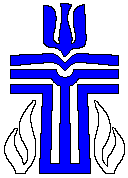 The dominant structural and theological element in the design is the cross — the universal and most ecumenical symbol of the Christian church. The cross represents the incarnate love of God in Jesus Christ and his passion and resurrection. Because of its association with Presbyterian history, the Celtic cross was chosen as a model for this contemporary rendering of the ancient symbol.
The dominant structural and theological element in the design is the cross — the universal and most ecumenical symbol of the Christian church. The cross represents the incarnate love of God in Jesus Christ and his passion and resurrection. Because of its association with Presbyterian history, the Celtic cross was chosen as a model for this contemporary rendering of the ancient symbol.
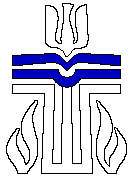 In experimenting with the basic lines and shapes of the cross, the contour of a book began to emerge in the horizontal section, and the two center lines of the cross became the representation of an open book. This integration of the horizontal dimensions of the cross with the book motif highlights the emphasis which the Reformed tradition has placed on the role of Scripture as a means of knowing God's word.
In experimenting with the basic lines and shapes of the cross, the contour of a book began to emerge in the horizontal section, and the two center lines of the cross became the representation of an open book. This integration of the horizontal dimensions of the cross with the book motif highlights the emphasis which the Reformed tradition has placed on the role of Scripture as a means of knowing God's word.
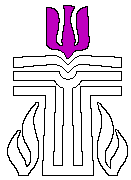 The slightly-flared shape of the Celtic cross also makes possible the transforming of the uppermost section into the shape of a descending dove. As a symbol of the Holy Spirit, the dove is intimately tied to the representation of the Bible, affirming the role of the Spirit in both inspiring and interpreting Scripture in the life of the church. The dove also symbolizes Christ's baptism by John and the peace and wholeness which his death and resurrection bring to a broken world.
The slightly-flared shape of the Celtic cross also makes possible the transforming of the uppermost section into the shape of a descending dove. As a symbol of the Holy Spirit, the dove is intimately tied to the representation of the Bible, affirming the role of the Spirit in both inspiring and interpreting Scripture in the life of the church. The dove also symbolizes Christ's baptism by John and the peace and wholeness which his death and resurrection bring to a broken world.
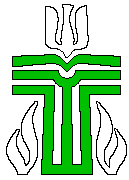 Beneath the image of the book is the suggestion of a lectern or pulpit, which captures the important role of preaching in the history of Presbyterian worship.
Beneath the image of the book is the suggestion of a lectern or pulpit, which captures the important role of preaching in the history of Presbyterian worship.
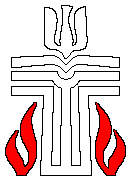 Integrated into the lower part of the design are flames which form an implied triangle, a traditional symbol of the Trinity. The flames themselves convey a double meaning: a symbol of revelation in the Old Testament when God spoke to Moses from the burning bush and a suggestion of the beginning of the Christian church when Christ manifested himself to his apostles at Pentecost and charged them to be messengers of the good news of God's love.
Integrated into the lower part of the design are flames which form an implied triangle, a traditional symbol of the Trinity. The flames themselves convey a double meaning: a symbol of revelation in the Old Testament when God spoke to Moses from the burning bush and a suggestion of the beginning of the Christian church when Christ manifested himself to his apostles at Pentecost and charged them to be messengers of the good news of God's love.
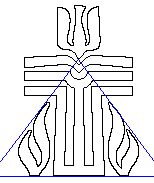 The triangle has always been used in Christian art to symbolize the Trinity. The Trinity is ultimately a mystery, but the concept is crucial in describing the nature of God as one God—“Father, Son, and Holy Spirit” known to us through God’s creating, redeeming, and sustaining power over all life. This mystery of three “persons” (or three ways of knowing God), unified in one reality, is at the heart of the idea of the Trinity.
The triangle has always been used in Christian art to symbolize the Trinity. The Trinity is ultimately a mystery, but the concept is crucial in describing the nature of God as one God—“Father, Son, and Holy Spirit” known to us through God’s creating, redeeming, and sustaining power over all life. This mystery of three “persons” (or three ways of knowing God), unified in one reality, is at the heart of the idea of the Trinity.
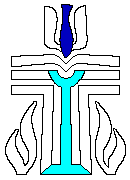 Looking more closely at some of the visual components of the design, viewers may discover elements that seem to fuse with some of the more obvious theological symbols. In the shape of the descending dove, for example, one might also discern in the body of the bird, the form of a fish, an early-Christian sign for Christ, recalling his ministry to those who hunger. For some, the overall design evokes the calligraphy of Hebrew and Greek manuscripts. Others have seen a baptismal font or a communion chalice (cup).
Looking more closely at some of the visual components of the design, viewers may discover elements that seem to fuse with some of the more obvious theological symbols. In the shape of the descending dove, for example, one might also discern in the body of the bird, the form of a fish, an early-Christian sign for Christ, recalling his ministry to those who hunger. For some, the overall design evokes the calligraphy of Hebrew and Greek manuscripts. Others have seen a baptismal font or a communion chalice (cup).
RETURN TO ABOUT US

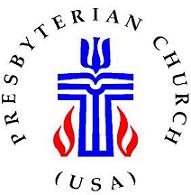
 Copyright © 2011-2014 First Presbyterian Church, Richmond, KY. All rights reserved.
Copyright © 2011-2014 First Presbyterian Church, Richmond, KY. All rights reserved.